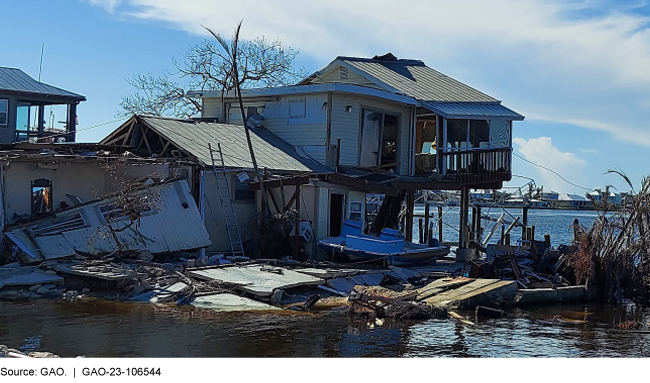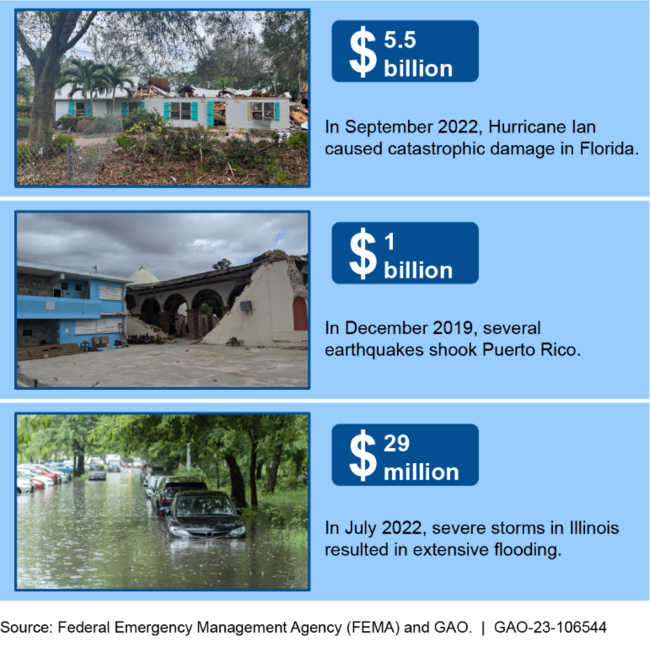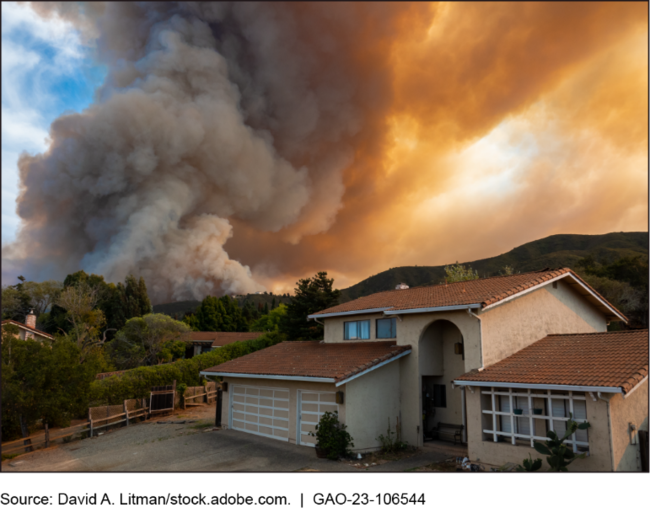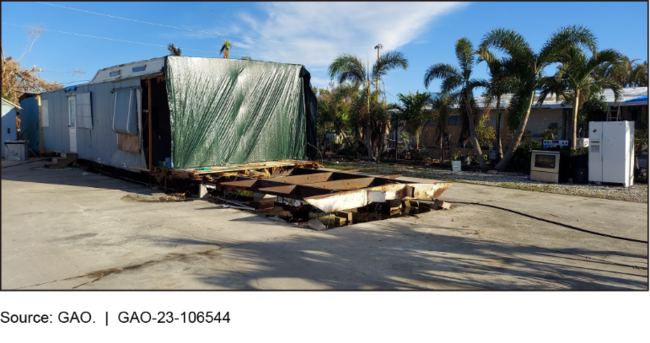Disaster Assistance: Action Needed to Improve Resilience, Response, and Recovery
Fast Facts
The federal government provides billions of dollars to help people before, during, and after disasters like wildfires and hurricanes. This Snapshot covers our work on disaster-related federal efforts.
We've found ways to improve federal efforts, including:
- Making it easier to get FEMA grants for disaster resilience projects
- Communicating better about FEMA assistance eligibility requirements
- Ensuring that HUD's housing-related disaster assistance reaches affected communities quickly
We also looked at federal coordination on disaster-related efforts—considering that there are more than 30 agencies and organizations involved.
A House in Pine Island, Florida, after Hurricane Ian in 2022

Highlights
The Big Picture
The federal government provides billions of dollars to help communities damaged by disasters—such as hurricanes, floods, wildfires, and earthquakes—rebuild infrastructure and improve their resilience to future damages. Federal assistance also helps individuals and households impacted by disasters recover.
FEMA-Reported Federal Assistance for Selected Natural Disasters, as of February 2023

The rising number of natural disasters and increasing reliance on federal assistance are key sources of increasing costs for the federal government and the American taxpayer.
What GAO’s Work Shows
GAO has evaluated federal disaster resilience, response, and recovery efforts and has identified opportunities for improvement.
Invest in Disaster Resilience. One way to reduce federal fiscal exposure is to invest in disaster resilience, thereby reducing the need for more costly future assistance. In 2019, GAO developed the Disaster Resilience Framework to help federal entities identify opportunities to promote disaster resilience.
The Federal Emergency Management Agency (FEMA) has grant programs that fund state and local projects to increase disaster resilience, such as elevating homes to prevent flood damage. However, challenges with these programs, including complex and lengthy application processes, discourage investment in projects to enhance disaster resilience.
✓ We recommended that FEMA develop a plan to streamline its grant application processes.
Improve Processes for Assisting Survivors. After a major disaster, survivors can apply to FEMA's Individuals and Households Program (IHP) for temporary housing or home repair funds. GAO found that survivors face numerous challenges obtaining aid. For instance, FEMA does not always fully explain to survivors that, in order to receive certain types of IHP assistance, they must first apply for and be denied a Small Business Administration (SBA) disaster loan. Survivors who do not understand such requirements may not receive all the assistance for which they are eligible.
✓ We recommended that FEMA improve communication about this requirement.
GAO has also identified issues with FEMA's process for estimating damage to homes. In 2020, FEMA changed its approach for estimating such damages. However, FEMA did not assess how such changes affected IHP award amounts. GAO found awards were 35 percent lower on average with the new approach. As a result, applicants may not receive an award amount that accurately reflects the damage for which they are eligible.
✓ We recommended that FEMA assess its new approach for estimating damage and adjust the approach as needed.
California Wildfire Approaching a Residence

Improve Federal Approach to Disaster Recovery. Funding provided by the Department of Housing and Urban Development's (HUD) Community Development Block Grant Disaster Recovery can be used for housing activities, such as home repairs. We found that this funding has been slow to reach affected communities. We reported in December 2022, that the seven states and territories that received the vast majority of grants to help affected communities recover from 2017 and 2018 disasters had disbursed only 28 percent of the funds allocated for housing activities. HUD does not require grantees to collect and analyze data needed to monitor program timeliness.
✓ We recommended that HUD require grantees to collect and analyze data to monitor grant timeliness.
Hurricane Ian Damage to Home in Pine Island, Florida

FEMA, HUD, and SBA are just three of over 30 federal entities involved in disaster recovery. Having so many entities involved has created challenges, such as confusing and lengthy processes for disaster survivors and communities to apply for assistance. Such challenges can disproportionately affect populations that are least prepared to navigate complex federal programs.
We identified 11 options that could improve the federal approach to disaster recovery.
✓ We recommended that Congress consider establishing an independent commission to recommend reforms to the federal approach to disaster recovery.
More from GAO's Portfolio
Disaster Assistance: GAO-23-104750, GAO-20-604, GAO-20-503
Disaster Recovery: GAO-23-105295, GAO-23- 104956, GAO-22-104452, GAO-19-232
Disaster Resilience: GAO-22-106046, GAO-21-140, GAO-20-100SP
Highway Emergency Relief: GAO-20-32
Puerto Rico Recovery: GAO-21-264 2017
Hurricanes: GAO-22-106211
